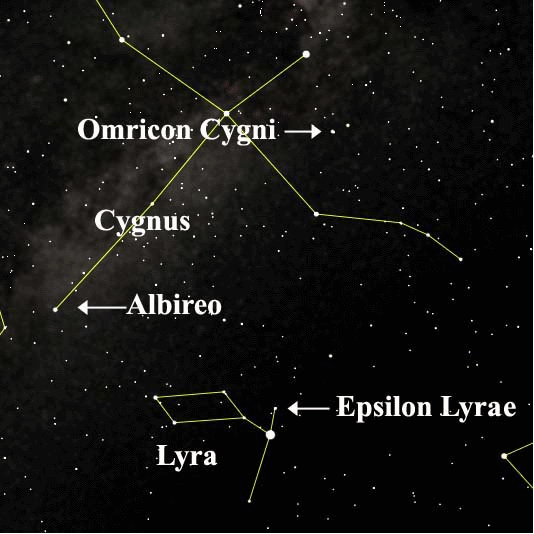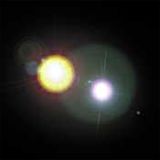
With the November Moon nearly full, the sky is too bright for most deep sky objects. But there is still plenty to see, and choosing a few good double stars to observe will satisfy that need to get out and observe.
As the Moon rises in the east, look to the west, for fine views in the constellations Lyra and Cygnus. Here you will find three of my favorite double stars for November skies. I am not including photos or drawings of these, so you can enjoy them without preconceptions!

Our area of Study for some November double stars.
A fascinating target, and one I return to over and over, is the multiple star Epsilon Lyra. It is known as "The Double Double." In a good clear sky, I can split the main pair of this multiple star system without optical aid, my eyes are just good enough. With a pair of binoculars, you will easily split the main components - and will see what appears to be a pair of stars. This "pair" of stars have a separation of just over three arc-minutes, at a distance from us of 162 light years. The brighter of the pair has an apparent brightness of magnitude 4.7, and the other of 5.1, so they appear quite similar.
If you point a telescope at the pair, you may have a nice surprise: each star in the pair is itself a pair of stars! That is why the target is called "The Double Double". The pairs of stars you'll see have different separations, and position angles (their position relative to each other). The wider pair is 2.6 arc-seconds apart, shining at magnitudes 4.7 and 6.2.
The tighter pair (and more difficult to split) is 2.3 arc-seconds separation and magnitudes 5.1 and 5.5. Can you split them? This system is in actuality two binary stars (with a common center of gravity) orbiting each other over a period of a hundred thousand years! Studies of other nearby stars associate a total of ten stars to this system, but The Double Double is the real star of the show for us!
Let's move to the constellation Cygnus, and the famous star Beta Cygni - also known as Albireo. Even a pair of binoculars will split this binary star. The primary component is a giant orange-red star, shining at magnitude 3.1, and its blue-green companion at 5.1. The color contrast of the pair is what has made it so well known. They are 430 light years distant, although estimates vary (I've read 320 light years as well), and have a 35 arc second separation - so this is a fairly wide pair, especially compared to the The Double Double.
A fun question regarding the stars of Albireo is which star would you expect to have a longer life, and why? Post your answers here. An interesting phenomena is to observe with others, looking at Albireo's colors. Color vision can vary greatly, and my experience is that people have very different perceptions of Albireo's colors! When you observe this, what do you see?
I'll finish with Omicron Cygni, a relatively unknown favorite I show people in my ten inch reflector. It is a contrasting color double star similar to Albireo, but not as bright. The stars are 30 and 31 Cygni, and can be spit in binoculars. The primary, 31 Cygni, appears orange is magnitude 3.8. The secondary star, 30 Cygni, is magnitude 4.8 and has a blue-green appearance. Why haven't I referred to them as companions or as a binary? The primary is 1400 light-years away, while the other is half that, at 720 light-years from Earth. So these are not a binary - they are an apparent double, or better described as a line-of-sight double, and are not physically associated with each other. If you look through a telescope, you'll also see that 31 Cygni is a binary star, with a "third" partner being blue star of magnitude 7.0!
As you get a feel for observing double stars, you may acquire a taste for a few of the types I've come to enjoy - colored doubles, which can be quite pleasing visually, and tight doubles that can be a challenge, requiring high power and excellent "seeing" (a very steady atmosphere) in order to split.
Even on a Full Moon night, there is plenty to see and do. Get your gear out, and give these a try!
Clear skies,
Mark
Chart courtesy Starry Night Pro.
Mark Wagner is a life-long astronomy enthusiast and deep sky observer. He has spent the past twenty years popularizing amateur astronomy in the San Francisco bay area through his writing and community building. A past president of the San Jose Astronomical Association, he founded what is now the annual Golden State Star Party in California. Please post if you have comments, questions, sketches or images you've taken of the targets mentioned above.






















